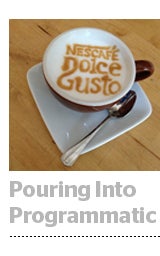 Nestlé found its sweet spot through a recently executed branding campaign for its Nescafé Dolce Gusto brand. For its first-ever wholly programmatic ad campaign, the European java vendor tapped UK-based online marketing firm Jellyfish to drive sales of its coffee machines. The goal was to maximize the efficiency of its display advertising, without compromising on viewability or brand safety.
Nestlé found its sweet spot through a recently executed branding campaign for its Nescafé Dolce Gusto brand. For its first-ever wholly programmatic ad campaign, the European java vendor tapped UK-based online marketing firm Jellyfish to drive sales of its coffee machines. The goal was to maximize the efficiency of its display advertising, without compromising on viewability or brand safety.
The campaign successfully delivered 91% of the ads to new visitors, at 21 percentage points more viewable vs. IAB standards, according to campaign results, and improved brand safety seven times over.
“The biggest takeaway from this campaign is that programmatic does work for branding campaigns,” said Gawain Owen, digital lead at Nestlé UK and Ireland. “A lot of people just think programmatic is for direct response. Tactically, the market has evolved over the last 12 months.”
Owen said the reason for this is that high-impact formats like homepage takeovers and other big ad units are increasingly appearing on top-tier websites in a programmatic fashion, with overlaid data to ensure brand safety.
“When people say programmatic is not working properly, it’s because they haven’t set out what the KPIs are,” Owen said, adding that those KPIs should center around viewability, brand safety and click-through rates.
The core KPI for the awareness part of Nestlé’s campaign was targeting new audiences while keeping viewability above 70%. Jellyfish also measured new unique visitors to Nestlé’s site in addition to the resulting coffee machine sales.
Jellyfish, one of the larger independently owned full-service media agencies in Europe and one of the smaller ones in the US, has roughly 250 employees at offices in London and Baltimore, with a smaller hub in South Africa. In the US, Jellyfish works with clients like Carfax, Protection One and Under Armour. Jellyfish’s UK clients include Nestlé, Experian and Fidelity Investments.
The Nestlé campaign marked a first for Jellyfish, according to James Bourner, head of display and RTB for Jellyfish, in that all elements of the endeavor were executed programmatically.
“We’ve never seen a campaign executed totally nose to tail in this way before,” Bourner said.
“All of the media-buying was facilitated through Jellyfish’s DSP, and awareness parts were set up using private marketplaces,” he said, explaining that Nestlé helped tie the campaign together with its site analytics package, which pushed user data from Nestlé’s sites in real time to Jellyfish’s buying system.
Though the campaign yielded positive results, Bourner said challenges remain for nose-to-tail programmatic media executions.
“We’re still ironing out the creases,” he said. “Quite often, my team would have to do a lot of troubleshooting to get it to work. There’s an operational element that, as an industry, we need to get better at.”
“Other concerns would be around inventory quality and content certification issues,” he added, explaining that including programmatic direct deals in campaign strategy is key to solving those issues.
In the longer term, Bourner said, advertisers need to make sure that all ad formats are easily accessible and measurable. The ability to track across devices is still a gray area, he added, and the industry will need to address that in order to get fully functioning campaigns that are executed wholly programmatically.
“At times, there can be a lack of premium, good-quality inventory,” Owen agreed. “But the counter to that is that publishers, from a yield-management perspective, are now starting to understand that the people buying inventory programmatically might be willing to pay more, because they’re buying on an impression-by-impression basis, which effectively translates to a higher CPM.”
Though Owen declined to specify how much Nestlé is currently investing in programmatic, he said the figure could grow as new ways to automate advertising emerge and more inventory becomes available.
“Programmatic inventory is opening up,” Owen said. “We have programmatic display, programmatic video, and people are now talking about programmatic television, programmatic out-of-home and programmatic print.”
“If we can eliminate waste to drive significant growth for our bottom line,” he added, “then programmatic is something we’d look to use more and more.”















